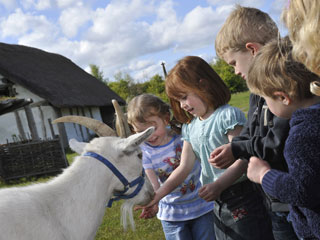LONDON, 2015-8-7 — /Travel PR News/ — Visits to England’s attractions increased by 4% in 2014, consolidating the sector’s return to growth following 2013’s positive figures, according to VisitEngland’s Annual Attractions Survey released today.
Key figures include:
- Attractions reported a healthy 4% annual increase in total visits in 2014
- All regions across England experienced growth in 2014, but the East of England saw the most significant increase with visitor numbers up by 10%
- The North East and North West experienced above average growth of 7% and 6% respectively
- Farms are the fastest growing visitor attraction category with visitor numbers up by 10%
- Warmer weather in 2014 supported greater growth in coastal regions – up 7% YOY
- All sectors, aside from places of worship experienced growth in visitor numbers
- Gross revenue across all attraction categories has increased by 5% YOY
- London attractions saw visitor numbers increase below the national average, but still achieve growth of +2%
- Since 1989 across England attractions as a whole, visits have increased 48% in that time.
The figures continue the growth of visitor numbers to England’s tourist attractions in 2013, demonstrating the important contribution attractions make to the tourism industry and the English economy, which is worth £106bn in total. The benefits were felt across the country; with regions across England seeing an increase in visitor numbers. The East of England saw the biggest rise – up 10% YOY, but the North West (+6%), North East (+7%), West Midlands (+5%) and the South East (+6%) all experienced above average growth (4%), indicating the important role attractions have in enticing people outside of London, to explore the country and experience what England has to offer.
As seen in previous years, certain types of attractions experienced more growth than others. Country parks, gardens, wildlife attractions/ zoos and historic houses / castles all experienced an increase in visitor numbers; with all attraction category sectors aside from places of worship seeing an increase in 2014. Farms and heritage centres enjoyed the most significant growth increase however, 10%+ YOY. This was supported by a number of farms across the country enjoying double digit growth including; Puxton Park in the South West (+25%) West Lodge Rural Centre, West Midlands (+20%) and the Donkey Sanctuary in the South West (+26%)
The research shows that those attraction businesses investing in marketing and digital platforms have seen an increase in visitor numbers. Visitor admissions increased by +7% among those increasing their marketing spend, compared with 2% of those who had cut back. This is highlighted by a third of farms increasing their marketing spend and achieving above average revenue growth of 7%.
83% of attractions now use at least one form of digital communication (outside of a website) and a quarter of sites in this year’s list offered an online booking facility for tickets / events – up from 21% in 2013.
Gross revenue across all attractions increased 5% YOY. Standout regional increases above the average included London (+7%), North West (+8%) and Yorkshire (+8%). Contributing to this was a 4% increase in adult admission fees for those charging for admission. Looking forward the survey also revealed that more attractions are planning to take on additional full-time staff.
The Tower of London remains the most visited attraction in the paid for category with 3.1 million visits, an increase of 6.5% on last year, followed by Westminster Abbey with 1.8 million visits. As seen in previous years, many of the most-visited paid for attractions were part of our rich history and heritage, such as Stonehenge, Houses of Parliament, Big Ben, the Roman Baths and Tatton Park.
Visits to free attractions were up 4% overall in 2014. The British Museum marked its seventh consecutive year as the most visited free attraction in England with 6.7 million visitors, followed by the National Gallery (6.4 million visitors, up 6.4% YOY). The Tate Modern saw an impressive growth of 18.4% to 5.8 million visitors in 2014, but The Imperial War Museum saw the greatest increase on the list, with 915,000 visitors – up 153% YOY due to their reopening in 2014.
Across the country, the most visited free attractions regionally include Brighton Pier, The Library of Birmingham, Ashmolean Museum andAvenham and Miller Park in the North West.
VisitEngland, Chief Executive James Berresford, said: “It is wonderful that attractions across the country are experiencing an increase in visitor numbers and the benefits are being felt across regions. We know that England has a fantastic range of unique and outstanding product, which generate high levels of satisfaction for visitors. Our attractions are core to England’s tourism offer; contributing to economic growth and employment and we are fortunate to have such a wonderful and wide variety available to suit all visitors”.
Tourism Minister Tracey Crouch said: “I’m delighted that more visitors are enjoying England’s world-class attractions, especially after English tourism experienced a record-breaking start to the year. I’m looking forward to working with the tourism industry to build on this success with the government’s new five point plan for tourism – which aims to attract even more tourists to experience our amazing attractions, create great careers, and help local economic growth.”
Download the full press release for further details (PDF, 339KB)
Press enquiries:
For more information, please contact Kaye Woodhouse Tel: 0207 578 1244 Email: kaye.woodhouse@visitengland.org M: 07855 962 940 orAngelah Sparg, Head of Corporate Communications Tel: T: 0207 578 1482 | M: 07917 183 668 Email: angelah.sparg@visitengland.org or or website: www.visitengland.com/biz
Notes to Editors
The VisitEngland Annual Attractions Survey is carried out by BDRC-Continental and is based on a survey of 1,608 England visitor attractions.
For the full report see: Annual Survey of Visits to Visitor Attractions
- Please note ’Places of Work’ is defined as attractions such as breweries, distilleries, vineyards and premises where crafts are created.
- Please be aware that the Visits to Visitor Attractions Survey is a self completion survey. There is no obligation for any visitor attraction, or any parent company / group of attractions to supply data. VisitEngland does not verify data provided by an attraction beyond a basic ‘sense check’. In addition, visitor attractions have the option of taking part in the survey anonymously, meaning not all visitor attractions that participate in the survey are named in the report or included in ranked lists of attractions.
- For a number of the attractions, data has been included with kind permission of ALVA (Association of Leading Visitor Attractions), Historic England, The National Trust as well as several Destination Management Organisations.
- Country Parks are included in the most visited lists where visitors can visit an attraction at the park that meets our visitor attraction definition, such as a visitor centre or historic property and the figures provided reflect these visitors only. For more information on this, please see the full report.
- VisitEngland operates the Visitor Attractions Quality Scheme (VAQAS). The scheme boasts a reputation for instigating, modifying and shaping change to the customer experience at visitor attractions across England. Areas covered by the annual assessment include pre-arrival information, the website, journey planning, signage, welcome on arrival, toilets, catering and retail outlets. The scheme currently has over a thousand members.
- More information can be found on www.visitengland.com/biz and www.visitengland.com
About VisitEngland
- VisitEngland is the country’s national tourist board, sponsored by the Department for Culture, Media & Sport. We work in partnership with Government and the industry to develop the visitor experience across England, plan national tourism strategy, grow the value of tourism in England and provide advocacy for the industry and our visitors;. Our work is underpinned by robust research and customer insights.
- Over the last five years VisitEngland has invested over £57m of Government funding in English tourism. These investments have generated over £1.5 billion growth in visitor spending and to date have created over 28,000 jobs.
- England is a unique destination and a real powerhouse in global tourism. It represents 84 per cent of the total UK visitor economy, is worth £106 billion, and supports 2.6 million jobs.
- For further information and to access the latest in-depth market intelligence and statisticsvisit www.visitengland.com/biz or www.visitengland.com for consumer information.
###


